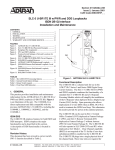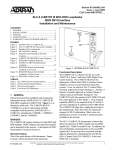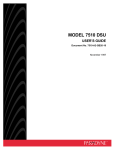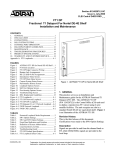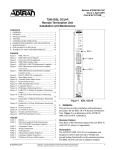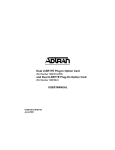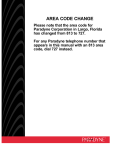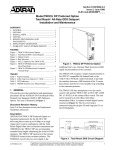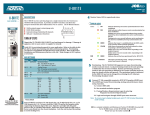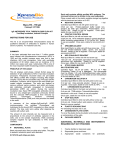Download ADTRAN D4 User's Manual
Transcript
Section 61104020L4-5C Issue 3, May 2002 CLEI Code: D4C5BENB_ _ D4 U-BR1TE V w/PWR and DDS Loopbacks ISDN 2B1Q Interface Installation and Maintenance CONTENTS 1. GENERAL .................................................................. 1 2. INSTALLATION ....................................................... 2 3. TESTING .................................................................... 7 4. MAINTENANCE ..................................................... 13 5. WARRANTY AND CUSTOMER SERVICE ......... 14 TABLES Table 1. SW1, SW3, and SW6 Option Settings ............... 5 Table 2. Rotary Switch Options ....................................... 7 Table 3. LED Indication ................................................... 7 1. GENERAL This practice provides installation and maintenance procedures for the ADTRAN D4 U-BR1TE V w/PWR and DDS Loopbacks, P/N 1104020L4. Figure 1 is an illustration of the U-BR1TE V. ISDN/DDS The U-BR1TE employs features for both ISDN and DDS transport. ISDN comprises the major functionality and is described in this section. A description of DDS functionality is located in Section 3. Revision History Issue 3 of this document includes 2B leased mode operation and revises the CLEI code. 61104020L4-5C 1104020L4 LPBK AD6 CRTX LPTX NT1 AD5 AD1 AD4 LP SW1 AD3 AD2 B1 B2 TEST CR 2 ACT TEST ERR 1 FIGURES Figure 1. ADTRAN U-BR1TE V ..................................... 1 Figure 2. Backplane Pin Assignments .............................. 3 Figure 3. Time Slot Assignments for 2B+D Service in SLC Mode I w/ D1D Counting ......................... 3 Figure 4. Time Slots that CANNOT Contain BR1TE Cards .................................................................. 4 Figure 5. SW1, SW3, and SW6 Labeling ......................... 4 Figure 6. Position Switch Settings at Network Locations for ISDN Applications ...................................... 6 Figure 7. U-BR1TE V IDSL/DDS Circuit Diagram ...... 10 Figure 8. IDSL/DDS Loopback Response ..................... 11 Figure 9. ADTRAN U-BR1TE Bidirectional Loopback .. 12 Figure 10. IDSL/DDS Remote End Initiated Loopback, Local Loop ...................................................... 12 Figure 11. IDSL/DDS Remote End Initiated Loopback, Customer Loop ................................................ 12 Figure 12. IDSL/DDS Trouble Codes .............................. 13 Figure 13. DS0 Latching Loopback ................................. 14 U-BR1TE V D4-UBR1PWR/DDS NORM OUT (Rx) SW3 IN (Tx) SW2 PTRN L O G I C SW4 SW5 SW6 Figure 1. ADTRAN U-BR1TE V Functional Description The U-BR1TE V is a line card that plugs into a single channel slot of an AT&T D4/SLC®-96 channel bank. It provides an ISDN U-interface and allows the transport of Basic Rate 2B+D information over T1 carriers and twisted pair wiring. The U-BR1TE V combines the functionality of a standard U-BR1TE V and a U-Repeater Powering Module which will simplify the installation of the U-Repeater. Span powering also allows deployment of 2-wire DDS when an IDSL OCU-R is used to terminate the ISDN local loop. This eliminates the need to provide AC power at the customer premises. The U-BR1TE V is used at both the Central Office Terminal and Remote Terminal locations. Clear channel capability (B8ZS) is not required of the T1 facility if zero byte substitution is enabled. The U-BR1TE V plugs into a single channel slot of the D4 bank, but can require three time slots when transporting 2B+D information. Block error rate performance over the T1 facility is monitored and is available to the network. Trademarks: Any brand names and product names included in this Section 61104020L4-5, Issue 3 document are trademarks, registered trademarks, or trade names of their respective holders. 1 Features The U-BR1TE V features support both ISDN and DDS, plus features common to both as listed here: ISDN Features • Span powers U-repeaters with 43 mA @ -28 to -120 VDC for ISDN applications. • Internal test pattern allows for testing of individual B Channels without requiring external test equipment. • Transportation of ISDN Basic Rate 2B+D information over T1 facilities in the 3-DS0 format specified in TR-NWT-000397. • B1 and B2 loopback addressability at the front panel for the NT1 and up to six devices in the Network-to-Customer direction. DDS Features • Span powers an IDSL OCU-R with 12 mA @ -120 VDC for DDS applications. • Transmit MUX-Out-of-Sync (MOS) trouble code upstream for IDSL loss of signal, loss of sync, or open loop. • Perform bidirectional loopback (loop and network) when commanded into DS0 DP loopback from the network direction only. • Initiate in-band OCU loopback to loop the IDSL OCU-R via front panel push button. • Loopback release in response to TIPs per TR62310 or front panel push button. • Remap all subsequent DS0 DP loopback codes into respective EOC loopbacks to loop back respective downstream U-Repeaters, TRISDN elements, and U-BR1TES when optioned for 1B+D, or 2B+D. • Pass OCU loopback code through to loop the IDSL OCU-R. • Pass CSU loopback code through to loop the CSU/DSU and simultaneously send a remap to the NT1 EOC address. • Returns Abnormal Station Code (ASC) to the network in B1 during loopback conditions initiated by the IDSL OCU-R. 2B Leased Mode Features • DDS loopback operation during 2B data mode only. Common Features • ISDN 2B1Q interface which meets all Layer 1 requirements as specified in ANSI T1.601-1991. • 18 kft nominal range on mixed gauge wire. 2 • All Layer 1 maintenance function and performance monitoring as specified in TR-NWT-000397 and TR-TSY-000829. • Distinctive metallic DC test signature to identify either line unit LT or line unit NT mode of operation as specified in TR-NWT-0000397. • Provides loopback capability for full 2B+D as well as individual B channels in both loop and carrier directions. Individual B channel loopbacks may be initiated at the U-BR1TE V front panel or from a remote location through the maintenance channel. • DS0 logic level transmit and receive data access through front panel bantam jacks. • A built-in Cyclic Redundancy Check (crc) clock error detector allows for local performance monitoring at the front panel without test equipment. • Addressing and error status with front panel LED indicators. Test function chosen by a front panel ten-position rotary switch. The U-BR1TE V is compatible in functionality and is interchangeable with the U-BR1TE III w/PWR (1103020L4) except when used in DDS applications. In addition to being compatible and interchangeable with the just mentioned ADTRAN unit, the U-BR1TE V, adds features in leased mode, including DS0 DP latching loopback and sending Multiplexer-Out-of -Sync (MOS) toward the network. 2. INSTALLATION C A U T I O N ! SUBJECT TO ELECTROSTATIC DAMAGE OR DECREASE IN RELIABILITY. HANDLING PRECAUTIONS REQUIRED. After unpacking the unit, inspect it for damage. If damage is noted, file a claim with the carrier, then contact ADTRAN. See Warranty and Customer Service. Physical Requirements The U-BR1TE V plugs into a single D4/SLC-96 channel slot. The backplane pin assignments are illustrated in Figure 2. When provisioned for basic rate service (2B+D), the U-BR1TE V occupies three time slots. In a D4 or SLC-96 Mode III channel bank, it occupies the time slot associated with the physical channel slot that it occupies plus the next two time slots to the right. The physical channel slots, whose time slots are used in this manner, must remain unoccupied. Section 61104020L4-5, Issue 3 61104020L4-5C +5V INCLK TDATA RCLK RWD RSQ -48V R* GND 28 1 29 2 30 3 31 4 32 5 33 6 34 7 35 8 36 9 37 10 38 11 39 12 40 13 41 14 42 15 43 16 44 17 45 18 46 19 47 20 48 21 49 22 50 23 51 24 52 25 53 26 54 27 In SLC-96 Mode I with D1D counting channel bank, the time slots are allocated as shown in Figure 3 with two time slots per physical channel slot. FRM GND -12V GND +12V GND TWD TSP TSQ RNPCN The unit uses two time slots in one physical slot and a time slot from an adjacent slot when configured for 2B+D operation. When selected for Slot 1, 4, 7, or 10 operation, the unit occupies the two time slots associated with the physical slot in which it resides and the upper time slot of the next adjacent physical slot. TDCLK NGATE RSP RNDIS -48R When selected for Slot 2, 5, 8, or 11 operation, the unit occupies the lower time slot of the occupied physical slot and the adjacent two time slots of the next physical slot to the right. When using the Slot 2, 5, 8, 11 option, the physical slot to the right must be left vacant. A unit selected for one or two time slots, B1+D, B2+D, B1, B2, 2B, and D only, occupies only the two time slots associated with the physical slot used. In this configuration, option the unit for Slot 1, 4, 7, or 10. NSEIZE T* MCLK *2B1Q Signal Terminals Figure 2. Backplane Pin Assignments UTS UTS UTS C1 C2 * LTS LTS LTS UTS = upper time slot PS4 PS5 PS6 PS7 PS8 PS9 PS10 PS11 PS12 C1 C2 C1 C2 C1 C2 Unoccupied PS3 Unoccupied PS2 Unoccupied PS1 LTS = lower time slot C1 = physical location of U-BR1TE optioned as "slots 1, 4, 7, 10" C2 = physical location of U-BR1TE optioned as "slots 2, 5, 8, 11" PS = physical slot (1 physical slot consists of 2 time slots) * = Must be empty - time slots are being used by U-BR1TE card in C2 NOTE: Unoccupied slots should have blank panels installed to prevent inadvertant use. Figure 3. Time Slot Assignments for 2B+D Service in SLC Mode I w/ D1D Counting 61104020L4-5C Section 61104020L4-5, Issue 3 3 See Figure 4 for additional channel slot deployment restrictions for each bank type. 3 4 5 6 7 8 9 10 11 12 3 4 5 6 7 8 9 10 11 12 13 14 15 16 17 18 19 20 21 22 23 24 13 14 15 16 17 18 19 20 21 22 Time Slots 5 6 7 17 21 2 3 7 11 15 19 D4 Bank: D1D Channel Counting, or SLC-96 Carrier Mode 3 Terminal: D4 Channel Counting 9 10 11 12 6 8 10 14 18 22 8 12 16 20 24 11 12 ** 3 2 7 3 4 11 15 1 5 9 13 13 14 15 16 5 23 6 * ** ** *21 17 ** ** 17 18 19 23 ** 4 7 9 10 8 12 16 2 6 10 14 19 20 21 4 8 Physical Slots Time Slots Physical Slots 22 * ** ** * 18 22 ** ** 23 24 Physical Slots 11 Physical Slots 1 2 3 4 5 6 7 8 9 10 1 3 5 7 9 11 13 15 17 19 2 4 6 8 10 12 14 16 18 20 13 14 15 16 17 18 19 20 21 22 20 24 12 * ** ** * 22 24 ** ** 23 24 21 Time Slots Option Switch Settings Figure 5 displays the locations for SW1, SW3, and SW6 on the U-BR1TE V. Table 1 contains the option settings for SW1, SW3, and SW6 of the U-BR1TE V. 23 Time Slots Physical Slots * A channel unit with B+D service cannot occupy this slot ** A channel unit with 2B+D service cannot occupy this slot LULT(RT) O 1 SW3 N 2 O 1 2 3 4 5 6 N SW2 Figure 4. Time Slots that CANNOT Contain BR1TE Cards LUNT(COT) TANDEM LULT(RT) SW3 D4 Bank Requirements The COT D4 bank must be configured with an OIU-2 selected for external timing. The COT bank must be provided with an external composite clock synchronized with the network. ADJ B1 B2 D ZBS DIS 4 13 Interface Requirements The U-BR1TE V unit includes two interfaces. The loop-side interface is an ISDN U-interface which is used to deliver Basic Rate service. The carrier-side interface is a D4/SLC-96 channel bank interface which is used to insert data into the 1.544 Mbps T1 stream. Only the polarity-insensitive T and R leads are used in the cross-connection. TRM 3 9 Physical Slots ZBS EN 2 5 ** ** 23 24 SW6 O N 1 ADJ 2 LUNT(COT) TANDEM NORM POWER O1 2 3 4 5 6 N SW4 NORM POWER SW1 ZBS EN 1 1 1 SLC-96 Carrier Mode 3 Terminal: D1D Channel Counting Physical Slots B1 B2 D ZBS DIS SLC-96 Carrier Mode 1 Terminal: D1D Channel Counting 2 2 TRM D4 Bank: D4 Channel Counting 1 1 SLC-96 Bank Requirements The COT SLC-96 bank must be configured with a special service unit (SSU) selected for external timing. The COT SLC-96 bank must be provided with an external composite clock synchronized with the network. Figure 5. SW1, SW3, and SW6 Labeling 4 Section 61104020L4-5, Issue 3 61104020L4-5C Table 1. SW1, SW3, and SW6 Option Settings Switch SW1-1 SW1-2 SW1-3 SW1-4 SW1-5 Label TRM TRM B1 B2 D SW1-6 On Off Description Bank Type Selection Selects the bank type for the U-BR1TE V. Service Level Selection ZBS DIS ZBS EN SW3-2 Count/Slot SW1-1 SW1-2 D4 D4 Counting D1D Counting On On Off On SLC I CU in slots 1, 4, 7, 10 CU in slots 2, 5, 8, 11 On Off On Off SLC III D4 Counting D1D Counting On Off On On ISDN 2B+D On On On Leased (128 kbps) 2B On On Off ISDN/DDS B1+D On Off On ISDN B2+D Off On On DDS/Leased B1 On Off Off Leased B2 Off On Off ISDN D Off Off On In 2B+D, B1+D, or B2+D the ZBS option must be set the same for the COT and RT. SW1-6 should be set toward "ZBS EN" for AMI-provisioned carriers. The switch setting is optional for B8ZS-provisioned carriers. In non-D channel modes, ZBS must be disabled when DDS service rate is 64 kbps, or 56 kbps with secondary channel. Consult local provisioning guidelines. Disables ZBS Enables ZBS Termination Mode LULT (RT) LUNT (COT) Bank Selects the service level. The U-BR1TE V may be optioned to deliver full ISDN (2B+D) or any of the following levels of service. Service SW1-3 SW1-4 SW1-5 Type Option (B1) (B2) (D) Zero Byte Substitution SW3-1 On Off Function This switch should be set toward "LULT" when the unit is installed as Adjacent-to U-Repeater, Adjacent-to-Customer, or Tandem Office Source configuration. This switch should be set toward "LUNT" for Adjacent-to-Switch and Tandem Office Sink configurations. LULT Mode (RT typical) LUNT Mode (COT typical) (See Figure 6) Function dependent upon SW3-1 setting. LULT Mode (SW3-1 On) DC sealing current provided DC sealing current not provided On Off ADJ TANDEM On Off ADJ TANDEM LUNT Mode (SW3-1 Off) In the LUNT(COT) mode, SW3-2 controls periodic wake-up tone. Periodic wakePeriodic wake-up tone not provided up tones should be disabled when located in an Adjacent-to-Switch location (SW3-2 Periodic wake-up tone provided On). Periodic wake-up tones are required (SW3-2 Off ) when located in a Tandem Office Sink configuration, or when adjacent to a device requiring wake-up tones, such as a Newbridge switch. SW6 On POWER Powering provided toward the customer U-interface. Automatically determines which of the following modes of operation is appropriate; • Supply a constant 43 mA to power an ADTRAN ISDN U-Repeater II, URepeater III. • Supply a constant -120 Vdc to power an ADTRAN IDSL OCU-R. Off NORM Normal No powering provided toward the customer U-interface. In the LULT(RT) mode, SW3-2 controls sealing current. When used in an Adjacent-to-Customer configuration, sealing current should be provided (SW3-2 On). In a Tandem Office Source configuration, sealing current is not required, and should be disabled (SW3-2 Off ). Note: Power option should only be used in the LULT (RT) configuration. 61104020L4-5C Section 61104020L4-5, Issue 3 5 Figure 6 displays the position switch settings at network locations. Front Panel Features The U-BR1TE V front panel features a two position DIP switch, a recessed pushbutton, a rotary switch, a bantam jack, and LEDs, as illustrated in Figure 1. The B1/B2 DIP Switch selects the desired bearer channel, B1 or B2, to be tested during local tests using the U-BR1TE V front panel. D4/SLC-96 COT 2-Wire L U N T D4/SLC-96 RT Channel Bank Channel Bank Adjacent to Switch Adjacent to Customer SW3 1 - LUNT (COT) 2 - ADJ ISDN Switch D4/SLC-96 RT L U L T T1 Channel Bank Channel Bank Adjacent to Switch Adjacent to Customer SW3 1 - LUNT (COT) 2 - ADJ 2-Wire ISDN RP 2-Wire Loop Customer NT1 2-Wire Customer NT1 Note: Refer to Table 1 for switch function descriptions. SW3 1 - LULT (RT) 2 - ADJ SW6 Norm SW6 Norm D4 D4 L U N T 2-Wire SW6 Power D4/SLC- 96 COT L U N T LED indicators display current status of the unit, as listed in Table 3. SW3 1 - LULT (RT) 2 - ADJ SW6 Norm 2-Wire L U L T T1 The NORM/PTRN DIP Switch is recessed to prevent inadvertent operation. The ten-position rotary switch is used to determine the specific test that will be performed, including downstream loopbacks (see Table 2). L U L T T1 2-Wire L U N T D4/SLC-96 RT D4/SLC-96 COT L U L T T1 Channel Bank Channel Bank Adjacent to Switch Tandem Office (Source) Tandem Office (Sink) SW3 1 - LUNT (COT) 2 - ADJ SW3 1 - LULT (RT) 2 - TANDEM SW3 1 - LUNT (COT) 2 - TANDEM SW3 1 - LULT (RT) 2 - ADJ SW6 Norm SW6 Norm SW6 Norm SW6 Norm Channel Bank 2-Wire Customer NT1 Channel Bank Adjacent to Customer Figure 6. Position Switch Settings at Network Locations for ISDN Applications 6 Section 61104020L4-5, Issue 3 61104020L4-5C Table 2. Rotary Switch Options Display Interpertation AD1 Address #1, address of this unit AD2 Address #2, the next downstream unit away AD3 Address #3, the second unit downstream AD4 Address #4, the third unit downstream AD5 Address #5, the fourth unit downstream AD6 Address #6, the fifth unit downstream LPBK Loopback, forces this unit to loopback the selected B1 or B2 channel. Loopbacks occur in both the customer and network directions. CRTX Carrier transmit, in the carrier direction LPTX Loop transmit, in the loop direction NT1 NT1, address of the NT1 Latching OCU in DDS mode 3. TESTING The U-BR1TE V responds to embedded operation channel loopbacks, including B1, B2, and 2B+D, when configured for D channel operation. When used in B1 configuration (non-D channel modes of operation) the U-BR1TE V will respond to an in-band DS0 DP latching loopback sequence. When remote testing is not available, or during isolation of trouble or equipment malfunction, the U-BR1TE V front panel provides local test capabilities. Using the internal 2047 pseudorandom test pattern generator or the bantam jacks allows craft personnel to test in both the downstream and upstream directions, including loopback for 6 addressable ISDN devices and the customer’s NT1. Table 3. LED Indication Indicator Loop Status (LP) Color Description Off Indicates loop synchronization has been established and no Near End Block Errors (NEBE) are being received from the Loop interface. Red Illuminated when U-interface is out of sync or has a loss of signal. Yellow Flashes yellow upon receipt of a NEBE. During Local Performance Monitoring (see Testing) will flash yellow when BER >10-6 is detected and illuminate yellow when a BER > 10-5 is detected. Off Indicates carrier synchronization (framing per TR-TSY-000397) has been established and no Near End Block Errors (NEBE) are being received from the Carrier interface. Red Illuminated when no framing pattern is received. Yellow Flashes yellow upon receipt of a NEBE. During Local Performance Monitoring (see TESTING) will flash when a BER > 10-6 is detected and illuminate yellow when a BER > 10-5 is detected. Activation (ACT) Green ISDN Application - Indicates that the terminal equipment has exchanged ACT bits with the ISDN switch. DDS Application - Indicates loop is terminated with an OCU-R. ISDN Application - Once per second indicates that the ACT bit is being sent in one direction only. Test (TST) Yellow Solid yellow when a front panel test has been successfully initiated or when responding to a 2B+D loopback request. Flashes yellow once every two seconds when responding to a B1 loopback request or when forced into a B1 loopback from the front panel. Flashes yellow twice every two seconds when responding to a B2 loopback request or when forced into a B2 loopback from the front panel. Green Solid Green when in Local Preformance Monitoring or when the local test pattern gen/det is invoked. Red Flashes red when errors are seen by local test pattern detector. Carrier Status (CR) Error (ERR) 61104020L4-5C Section 61104020L4-5, Issue 3 7 The front panel bantam jacks accommodate standard DS0 Logic Testers such as the TPI 108/109 RT II or FIREBERD 4000/6000 which perform both the upstream and downstream testing. NOTE On DDS circuits the internal 2047 Pattern Generator on the U-BR1TE V should be used only when the service is operating at 64 kbps. If DDS service is operating at 56 kbps or less, the U-BR1TE V will display errors if the internal 2047 Pattern Generator is used. The use of external DDS test equipment is required for all data rates at 56 kbps and below. Loopback Tests (ADR1 - ADR6, NT1) Loopbacks in the Network-to-Customer direction can be initiated from either the ISDN switch or the front panel. Either the internal 2047 test pattern or a DS0 digital test set provide the 64 kbps test pattern to be tested in B1 or B2. When initiating loopbacks from the U-BR1TE V front panel, the downstream direction is automatically selected based on the card position in the network. To initiate a loopback using the internal 2047 test pattern, perform the following: 1. Select the desired loopback address using the tenposition rotary switch. See Table 2. 2. Select the desired bearer channel using the B1/B2 DIP switch. 3. Select PTRN on the NORM/PTRN DIP switch. 4. Depress the recessed TEST pushbutton to initiate the test. The TEST LED will illuminate GREEN when the loopback is established to the selected address, and the ERR LED should go out following synchronization to the test pattern. If the selected address does not respond, the TEST LED will remain out and the ERR LED will illuminate. 5. To insert one bit error, momentarily (for less than two seconds) depress the TEST pushbutton. The ERR LED should flash upon receipt of the injected error. 6. Tests to additional network addresses may be performed by changing the selector knob to the desired address. It is not necessary to exit the test mode to select a new address. 8 7. To deactivate the loopback, depress the TEST pushbutton for two seconds, until the GREEN TEST LED is extinguished, or select NORM on the NORM/PTRN DIP switch. To initiate a loopback at any data rate when using an external DS0 digital test set, perform the following: 1. Insert the TX and RX bantam plug of the DS0 digital test set into the U-BR1TE V respective front panel bantam jacks. Connect the clock input of the DS0 digital test set to the channel bank’s clock source (the D4 OIU, or the SLC-96 SSU). Configure the test set for Near Logic and 64 kbps. 2. Select the desired loopback address using the tenposition rotary switch. See Table 2. 3. Select the desired bearer channel using the B1/B2 DIP switch. 4. Depress the recessed TEST pushbutton to initiate the test. The TEST LED will illuminate YELLOW when the loopback is established to the selected address. If the selected address does not respond, the TEST LED will remain off. Observe the DS0 digital test set for bit errors. 5. Tests to additional network addresses may be performed by changing the selector knob to the desired address. It is not necessary to exit the test mode to select a new address. 6. To deactivate the loopback, depress the TEST pushbutton or remove the transmit bantam plug. Upon deactivation of the test, the TEST LED will go out. Point-to-Point Test (CRTX, LPTX) A point-to-point (straight-away) test can be performed to either the U-interface (LPTX) or the T-1 carrier interface (CRTX). In both cases, either the internal 2047 test pattern generator or a DS0 DP digital test set is used to verify the performance of the selected bearer channel. To initiate a point-to-point test using the internal 2047 test pattern, perform the following: 1. Select the desired test direction, LPTX or CRTX, using the ten-position rotary switch. See Table 2. 2. Select the desired bearer channel using the B1/B2 DIP switch. 3. Select PTRN on the NORM/PTRN DIP switch. Section 61104020L4-5, Issue 3 61104020L4-5C 4. Depress the recessed TEST pushbutton to initiate the test. The TEST LED will illuminate GREEN and the ERR LED should go out following synchronization to the test pattern from the far end. 5. If the far end unit is a U-BR1TE V using the internal 2047 test pattern, perform steps 1 through 4, choosing the same front panel switch setting. If the far end is a test set, ensure it is configured for a 2047 test pattern. 6. To insert one bit error, momentarily (for less than two seconds) depress the TEST pushbutton. Bit errors will be seen at the far end test unit. 7. To deactivate the loopback, depress the TEST pushbutton for two seconds, until the GREEN TEST LED is extinguished, or select NORM on the NORM/PTRN DIP switch. Upon deactivation of the test, the TEST LED will go out. To initiate a point-to-point test using an external DS0 digital test set, perform the following: 1. Insert the TX and RX bantam plug of the DS0 digital test set into the U-BR1TE V respective front panel bantam jacks. Connect the clock input of the DS0 digital test set to the channel banks clock source (D4’s OIU, or the SLC-96 SSU). Configure the test set for Near Logic and 64 kbps. 2. Select the desired test direction, LPTX or CRTX, using the ten-position rotary switch. Refer to Table 2. 3. Select the desired bearer channel using the B1/B2 DIP switch. 4. Depress the recessed TEST pushbutton to initiate the test. The TEST LED will illuminate YELLOW. 5. If the far end unit is a U-BR1TE V using a DS0 digital test set, perform steps 1 through 4, choosing the same front panel switch setting. Ensure that both test sets are configured for the same test pattern (511, 2047). If the far end unit is a U-BR1TE V using the internal 2047 test pattern, perform steps 1 through 4 of the previous section. 6. Observe the DS0 digital test set for bit errors. 7. To deactivate the loopback, depress the TEST pushbutton, or remove the transmit bantam plug. Upon deactivation of the test, the TEST LED will go out. 61104020L4-5C Local Loopback (LPBK) A bilateral loopback can be initiated from the U-BR1TE V front panel for either bearer channel. A local test pattern source is not required for this test. To initiate a local loopback, perform the following: 1. Select the desired bearer channel using the B1/B2 DIP switch. 2. Select LPBK using the ten-position rotary switch. See Table 2. 3. Depress the recessed TEST pushbutton to initiate the test. The TEST LED will illuminate YELLOW. 4. To deactivate the loopback, depress the TEST pushbutton. Upon deactivation of the test, the TEST LED will go out. Local Performance Monitoring Performance Monitoring of the local T1 carrier system and 2-wire U-interface of the ISDN data can be performed from the front panel without interruption of service to the customer. For this test, bearer channel selection is not applicable and a test pattern source is not required. To initiate a local performance monitoring session, perform the following: 1. Ensure the NORM/PTRN DIP switch is in the NORM position, and that a bantam plug is NOT installed in the front panel TX bantam jack. 2. Select ADR1 using the ten-position rotary switch. 3. Depress the recessed TEST pushbutton to initiate the test. The TEST LED will illuminate GREEN. 4. The total number of Near End Block Errors (NEBE) received are simultaneously displayed as crc errors with the LP and CR CRC status LEDs. (See Table 3). 5. To exit local performance monitoring, depress the TEST button for two seconds or longer. Upon deactivation of the test, the TEST LED will go out. Section 61104020L4-5, Issue 3 9 IDSL/DDS Description The U-BR1TE V may be deployed in the adjacent to customer position to provide transport for DDS/Frame Relay services with an ADTRAN IDSL OCU-R. This allows pair savings over traditional DDS deployment on local loops up to 18 kft of mixed gauge wire. The IDSL OCU-R is used to terminate the U-interface at the customer’s premises provided by the U-BR1TE V and to convert the 2-wire ISDN signal to a 4-wire AMI DDS signal for presentation to the customer. Together, the U-BR1TE V and IDSL OCU-R allow testing over the ISDN transport network to be performed with traditional DDS methods. In this mode U-BR1TE Vs may be placed in tandem and function as DS0 DPs while the IDSL OCU-R functions as an OCU. See Figure 7 for various U-BR1TE V DDS arrangements. DDS Testing For leased mode or DDS applications with the U-BR1TE V the D channel is typically disabled. Without the D channel, standard ISDN EOC loopbacks are unavailable to the ISDN transport system and testing may only be accomplished by using the in-band DDS loopback commands. The U-BR1TE V responds to latching loopback sequences for the DS0 DP. The U-BR1TE V allows the OCU loopback command to pass in-band downstream to the IDSL OCU-R. Upon receipt of a DS0 DP latching loopback sequence the U-BR1TE V initiates a bilateral loopback for the B1 channel. This bilateral loopback allows testing of the 2B1Q local loop to the IDSL OCU-R simultaneously with network testing to the U-BR1TE V. SLC 96 A 1 4W DS0 DP or OCU B T1 4W Digital C 4W DS0 DP or DCS 4W DS0 DP or DCS T1 2-Wire Local Loop U-BR1TE 1B E IDSL OCU-R Customer Premises RT D4/DCS D4 D COT/DCS SW3 1 - LULT (RT) 2 - ADJ SW6 Power Non-ADTRAN U-BR1TE 1B+D A 2 4W DS0 DP or OCU B T1 2W Digital D C U-BR1TE 1B U-BR1TE 1B+D D4 COT T1 2-Wire Local Loop U-BR1TE 1B+D E IDSL OCU-R Customer Premises RT SW3 1 - LULT (RT) 2 - TANDEM D4 SW6 Normal 3 4W Digital A B 4W DS0 DP or OCU 4W DS0 DP or DCS 4W DS0 DP or DCS D4 D4 T1 C D T1 U-BR1TE 1B 2-Wire Local Loop E IDSL OCU-R Customer Premises D4 D4 Equipment Requirements 1 D & 3 D: Must be 1104020L4 w/ power enabled SW3 1 - LULT (RT) 2 - ADJ SW6 Power 2 B: Must be 1104020L4 w/ Power Disabled 2 E: Requires local AC power NOTE: Refer to Table 1 for DIP switch function descriptions. Figure 7. U-BR1TE V IDSL/DDS Circuit Diagram 10 Section 61104020L4-5, Issue 3 61104020L4-5C DS0 DP Loopback EOC Remapping Upon receipt of subsequent DS0 DP loopback codes when the D channel is disabled, the U-BR1TE V remaps the subsequent DS0 DP loopback sequences into the respective ISDN EOC loopback messages. This capability will permit all downstream ISDN D channel enabled U-BR1TEs, U-Repeaters, and TRISDN elements to respond to standard DDS DS0 DP loopback commands via the ISDN EOC as shown in Figure 8. Test Head D4/SLC-96 T1 U-BR1TE 1B+D U-BR1TE 1B DS0 DP #1 DS0 DP #2 Loopback ISDN RPTR IDSL OCU-R DS0 DP #3 OCU Response Figure 8. IDSL/DDS Loopback Response NOTE For DDS circuits with the D channel disabled, all tandem U-BR1TE elements should be ADTRAN U-BR1TE Vs with DDS Loopback Capability for remote end test operation to function properly. See 2B in Figure 7. In D channel disabled applications, older non-DDS vintage U-BRITEs may not pass the OCU latching loopback sequence to the IDSL OCU-R. Upon receipt of an OCU latching loopback sequence the U-BR1TE V passes the OCU sequence in-band downstream to the IDSL OCU-R. U-BR1TE Vs do not respond to the CSU latching loopback command but simultaneously pass it through to the CSU/DSU while mapping the NT1 EOC address. The IDSL OCU-R reverses sealing current on its 4-wire AMI DDS interface to place the customer CSU into loopback upon receipt of the CSU latching loopback. 61104020L4-5C The following data sequence enables the DS0 DP, OCU, and CSU latching loopbacks: 1. Minimum of 35 transition in progress (TIP) bytes (X0111010). 2. Minimum of 35 loopback select code (LSC) bytes: DS0 DP (X0000101),OCU (X1010101), CSU (X0110001). 3. Minimum of 100 loopback enable (LBE) bytes (X1010110). 4. Minimum of 32 far-end voice (FEV) bytes (X1011010). X Denotes Don’t Care bit - either a 1 or a 0. If the U-interface of the U-BR1TE V is not in sync, the unit transmits MUX-Out-of-Sync (X0011010). Disabling DS0 DP, OCU, or CSU latching loopback sequence: 1. Minimum of 35 TIP bytes. or by pressing the front panel loopback button. Front Panel Tests The valid front panel tests in leased modes are ADR1, CRTX, LPTX, and LPBK for all circuit positions. NT1, ADR1-ADR6 loopback tests are valid for the LULT mode only. ADR2 would be used to test a URepeater or ADR2 and ADR3 would be used to test TRISDN elements respectively. All active in-band loopbacks may be disabled by pressing the front panel loopback button once when a test set is not connected to the bantam jacks. Initiate Loopback at IDSL OCU-R When used for DDS, the D4 U-BR1TE may initiate a loopback at the IDSL OCU-R. The in-band latching OCU loopback code is sent to loop the IDSL OCU-R when the NT1 address is selected on SW2. To invoke the OCU loopback at the IDSL OCU-R, press the Test button with the front panel test knob in the NT1 address location. Section 61104020L4-5, Issue 3 11 Performance Monitoring Local Performance Monitoring is available only for the U-interface, when configured for a leased mode of operation. See the subsections entitled Loopback Tests, Point-to-Point Test, and Local Loopback for applicable test descriptions. ADTRAN U-BR1TE Bidirectional Loopback In LULT Mode, the ADTRAN U-BR1TE will execute a bidirectional loopback when performing DS0 DP loopback. See Figure 9 for an illustration of the bidirectional loopback. Remote End Initiated LBK Tests The U-BR1TE supports loopbacks generated from the remote unit which allows testing to be performed ADTRAN U-BR1TE IDSL OCU-R Test Set without coordination with the CO or test center. Loopbacks initiated by the OCU-R front panel LBK pushbutton aid in system turn up testing or troubleshooting from the remote end. The U-BR1TE responds to a loopback command initiated at the OCU-R as follows: Pressing the OCU-R LBK pushbutton on the OCU-R once will initiate a loopback at the U-BR1TE toward the customer. See Figure 10. This allows data to be sent from the remote end to test the local loop and the OCU-R. This loopback is indicated by a flashing CUST LBK LED on the IDSL OCU-R and a solid LBK LED on the U-BR1TE. Pressing the OCU-R LBK pushbutton a second time will initiate a loopback at the OCU-R toward the 4-wire DDS (CPE) interface. A solid CUST LBK LED on the IDSL OCU-R indicates a loopback at the IDSL OCU-R toward the customer equipment. See Figure 11. Pressing the OCU-R LBK pushbutton a third time disables all current latching loopbacks initiated by the OCU-R LBK pushbutton. Bidirectional loopback Figure 9. ADTRAN U-BR1TE Bidirectional Loopback If errors exist the loopbacks can help determine the source; either the local loop or the OCU-R. 4-Wire CPE Interface OCU-R ASC 9Eh U-BR1TE Local Loop Test Set Loopback Pushbutton Push once for U-BR1TE Loopback Figure 10. IDSL/DDS Remote End Initiated Loopback, Local Loop 4-Wire CPE Interface ASC 9Eh OCU-R ASC 9Eh U-BR1TE Local Loop Loopback Pushbutton Test Set Push twice for OCU-R Loopback Figure 11. IDSL/DDS Remote End Initiated Loopback, Customer Loop 12 Section 61104020L4-5, Issue 3 61104020L4-5C During a remote end initiated loopback the system transmits ASC 9Eh toward the network, indicating an out-of-service condition generated by the remote end, as shown in Figures 10 and 11. All IDSL/DDS system latching loopbacks, whether initiated by the IDSL DCU-R craft interface, LBK pushbutton, CO, or from a remote Test Center, can be released by sending 35 DDS loop down TIP bytes <X0111010> (Where X is a “don’t care” bit). All existing latching loopbacks will also be disabled by pressing the LBK pushbutton on the CO or remote unit. NOTE The remote end test feature is only supported when the upstream U-BR1TE is an ADTRAN D4 or Series 5 U-BR1TE with DDS Loopback capability. Other U-BR1TEs will ignore the loopback command sent by pressing the IDSL OCU-R LBK button. IDSL/DDS Trouble Code The IDSL/DDS system provides a quick diagnosis in the case of a circuit condition where continuity is broken. The trouble code type received by a tester determines whether the open condition is occurring on the local loop or at the customer premises. In the event of a 2-wire DSL loss of signal, loss of sync, or open condition caused by an open conductor or disconnected 2-wire loop, the U-BR1TE V transmits a MUX-Out-of-Sync trouble code (MOS 9Ah) into the network as shown in Figure 12. During a similar out-of-service condition at the customer premises, the IDSL OCU-R transmits Abnormal Station Code (ASC 9Eh) upstream toward the network as shown in Figure 12. Customer Premises Channel Bank Open 2-wire Loop MOS 9Ah U-BR1TE IV IDSL OCU-R DSU 2B Leased Mode Operation The U-BR1TE V is deployed in 2B leased line operation to provide DDS/Frame Relay services to ISDN equipment. By using the 2-wire ISDN interface for 128 kbps data rate, the U-BR1TE V Leased Mode Operation allows pair savings over traditional DDS deployment. DDS/Frame Relay support allows loopback testing to be performed across the ISDN transport system in this configuration. The U-BR1TE V will decode DDS latching loopback sequences coming from the carrier into eoc loopback commands usable by traditional ISDN equipment. See Figure 13 for various U-BR1TE V DDS 2B Leased Mode arrangements. In a SLC-96 network the U-BR1TE V units will operate in both 2B+D or 2B mode. Both units must be in the same mode. Loopback Operation To enable detection of DDS latching loopbacks, the ADTRAN U-BR1TE V must be provisioned as an LT- like device in leased 128 kbps (2B) mode of operation. When B1 and B2 are enabled, data on both channels are looped in response to a DDS latching loopback sequence detected on channel B1. The U-BR1TE V will respond to a DS0 latching loopback intended for DS0 #1. Loopback commands intended for DS0 #2 and greater are re-mapped to ISDN eoc loopback commands addressed to the appropriate unit. The U-BR1TE V will map a CSU latching loopback sequence to an ISDN eoc NT1 loopback. Figure 13 shows the DDS latching loopback commands that will loop each unit. NOTE Only the B1 channel will detect the DDS loopback sequences for activation and deactivation of DS0 and CSU latching loopbacks. All standard U-BR1TE units between the ADTRAN U-BR1TE V and the NT1 device must have the D-channel enabled in order for loopbacks to be processed beyond the U-BR1TE V. Customer Premises Channel Bank Open 4-Wire Customer Interface ASC 9Eh ASC 9Eh U-BR1TE IV IDSL OCU-R DSU Figure 12. IDSL/DDS Trouble Codes 61104020L4-5C Section 61104020L4-5, Issue 3 13 4. MAINTENANCE The ADTRAN U-BR1TE V does not require routine maintenance for normal operation. ADTRAN Sales Pricing/Availability (800) 827-0807 5. WARRANTY AND CUSTOMER SERVICE ADTRAN will replace or repair this product within ten (10) years from the date of shipment if it does not meet its published specifications or fails while in service. Refer to ADTRAN U.S. and Canada Carrier Networks Equipment Warranty, document 60000087-10. ADTRAN Technical Support Pre-sales Applications/Post-sales Technical Assistance (800) 726-8663 Contact Customer and Product Service (CAPS) prior to returning equipment to ADTRAN. ADTRAN Repair/CAPS Return for Repair/Upgrade (256) 963-8722 For service, CAPS requests, or further information, contact one of the following numbers: Standard hours: Monday-Friday, 7 a.m. - 7 p.m. CST Emergency hours: 7 days/week, 24 hours/day Repair and Return Address ADTRAN, Inc. CAPS Department 901 Explorer Boulevard Huntsville, Alabama 35806-2807 D4 Channel Bank T1 NT 1 or TA U-BR1TE V 2B DS0 DP #1 SW 3 1 - LULT 2 - ADJ SW 6 NORMAL CSU D4 Channel Bank COT DLC Application T1 U-BR1TE 2B + D U-BR1TE V 2B RT T1 DSO DP #2 DS0 DP #1 SW 3 1 - LULT 2 - TANDEM SW 6 NORMAL U-BR1TE 2B + D NT 1 or TA DSO DP #3 CSU U-BR1TE (Non-ADTRAN) SLC-96 D4 Channel Bank T1 2B LULT DS0 DP #1 SW 3 1 - LULT 2 - TANDEM SW 6 NORMAL U-BR1TE V LUNT D4/SLC-96 COT 2B + D or 2B U-BR1TE V T1 D4/SLC-96 RT 2B + D or 2B LULT DSO DP #2 DSO DP #3 SW 3 1 - LUNT 2 - TANDEM SW 6 NORMAL SW 3 1 - LULT 2 - ADJ SW 6 NORMAL NT 1 or TA CSU Figure 13. DS0 Latching Loopback 14 Section 61104020L4-5, Issue 3 61104020L4-5C














